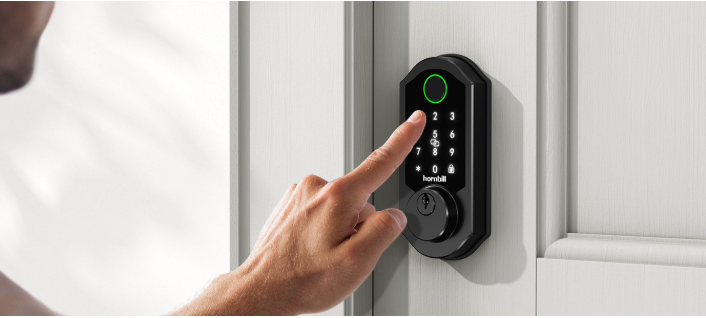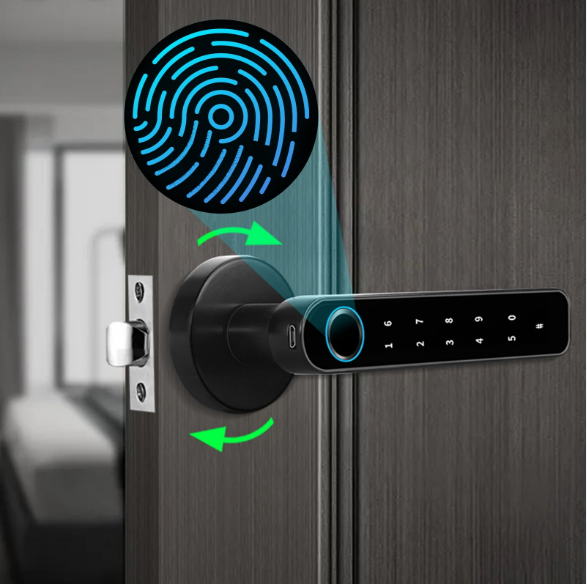Smart locks have revolutionized home security, offering keyless entry, remote access, and seamless integration with smart home systems. However, like any technology, they come with both advantages and drawbacks. In this comprehensive guide on the pros and cons of smart locks, we’ll explore why these devices are gaining popularity and what challenges they present. From smart lock installation to smart lock safety, we’ll cover key considerations, including smart lock setup, smart lock battery life, and smart lock troubleshooting, to help you decide if a smart lock is the right choice for your home. For more insights, check out our smart lock guide.
What Are Smart Locks?
Smart locks are electronic locking devices that replace or enhance traditional deadbolts, allowing keyless entry via smartphones, keypads, biometrics, or voice commands. They connect via WiFi or Bluetooth, offering features like remote access, temporary codes, and activity logs. Popular models include the August Wi-Fi Smart Lock, Schlage Encode, and Yale Assure Lock 2. This article on the pros and cons of smart locks evaluates their benefits and limitations for homeowners, renters, and property managers.
Pros of Smart Locks
Smart locks offer significant advantages, making them a compelling choice for modern homes. Here are the key benefits:
1. Convenience and Keyless Entry
Benefit: Smart locks eliminate the need for physical keys, allowing entry via smartphone apps, PIN codes, fingerprints, or voice commands.
- Example: The August Wi-Fi Smart Lock’s auto-unlock feature opens the door as you approach, ideal for hands-free entry when carrying groceries.
- Impact: No more fumbling for keys or worrying about losing them. Temporary codes or eKeys simplify access for guests, cleaners, or Airbnb renters.
Best For: Busy households, short-term rental hosts, and those prone to misplacing keys.
2. Remote Access and Control
Benefit: WiFi-enabled smart locks allow you to lock or unlock your door from anywhere using a smartphone app.
- Example: The Schlage Encode lets you grant access to a delivery person or check the lock status while on vacation.
- Impact: Enhances flexibility for property managers and travelers, ensuring peace of mind.
Best For: Landlords, Airbnb hosts, and frequent travelers needing remote management.
3. Enhanced Smart Lock Safety
Benefit: Smart locks offer advanced security features like encryption, tamper alerts, and activity logs.
- Example: The Yale Assure Lock 2 provides AES-128 encryption and real-time entry notifications, while the August’s DoorSense ensures the door is closed.
- Impact: Activity logs track who enters and exits, and encryption protects against hacking, boosting smart lock safety.
Best For: Security-conscious homeowners and rental property managers.
4. Smart Home Integration
Benefit: Smart locks integrate with platforms like Alexa, Google Assistant, and Apple HomeKit for voice control and automations.
- Example: With the August Wi-Fi Smart Lock, you can say, “Alexa, lock the door,” or set it to lock when your smart lights turn off.
- Impact: Simplifies home automation, creating a cohesive smart home experience.
Best For: Tech-savvy users with existing smart home ecosystems.
5. Renter-Friendly and Portable Options
Benefit: Retrofit smart locks, like the SwitchBot Lock, install over existing deadbolts without permanent changes, making them portable smart locks.
- Example: The August Wi-Fi Smart Lock installs in 5–10 minutes and can be removed without damaging the door.
- Impact: Ideal for renters or temporary setups, as landlords retain key access.
Best For: Renters and Airbnb hosts needing non-invasive solutions.
6. Cost Savings for Rental Properties
Benefit: Smart locks eliminate rekeying costs during tenant turnover by using temporary codes or eKeys.
- Example: The Schlage Encode supports up to 100 codes, which can be deleted after a tenant leaves.
- Impact: Saves landlords $50–$100 per rekey, streamlining tenant transitions.
Best For: Property managers and short-term rental hosts.

Cons of Smart Locks
Despite their advantages, smart locks have limitations that may affect your decision. Here are the key drawbacks:
1. Higher Upfront Cost
Drawback: Smart locks are pricier than traditional deadbolts, with premium models costing $150–$350.
- Example: The Schlage Encode ($250–$300) is significantly more expensive than a $30–$50 traditional lock.
- Impact: The initial investment can be a barrier for budget-conscious buyers, especially for multiple doors.
Mitigation: Budget options like the Wyze Lock Bolt ($60–$80) offer basic features at a lower cost.
2. Smart Lock Battery Life and Maintenance
Drawback: Smart locks rely on batteries, requiring regular replacement or recharging, especially for WiFi models.
- Example: The August Wi-Fi Smart Lock lasts 3–6 months on CR123A batteries, which are pricier than AA/AAA batteries.
- Impact: Frequent smart lock maintenance can be inconvenient, and a dead battery could lock you out.
Mitigation: Choose Bluetooth locks (e.g., SwitchBot Lock, 6–12 months) for longer smart lock battery life, and keep spare batteries.
3. Connectivity Issues
Drawback: WiFi and Bluetooth smart locks can face connectivity problems, affecting remote access or app control.
- Example: Users report the August Wi-Fi Smart Lock’s auto-unlock lagging in areas with crowded WiFi networks.
- Impact: Unreliable connectivity can disrupt functionality, requiring smart lock troubleshooting.
Mitigation: Ensure a strong 2.4GHz WiFi signal for WiFi locks or stay within Bluetooth range (30–100 feet).
4. Potential Security Vulnerabilities
Drawback: While smart locks enhance smart lock safety, they’re not immune to hacking or technical failures.
- Example: Weak WiFi passwords or outdated firmware could expose locks like the Schlage Encode to cyberattacks.
- Impact: Cybersecurity risks require proactive measures like strong passwords and firmware updates.
Mitigation: Use two-factor authentication and keep firmware updated to minimize risks.
5. Installation Challenges
Drawback: Full deadbolt replacements require precise smart lock installation, which can be complex for DIYers.
- Example: Installing the Yale Assure Lock 2 (full replacement) may involve drilling, potentially damaging doors if done incorrectly.
- Impact: Renters may need landlord approval, and improper installation can cause mechanical issues.
Mitigation: Opt for retrofit locks like the August Wi-Fi Smart Lock or SwitchBot Lock for simpler installation.
6. Dependency on Technology
Drawback: Smart locks rely on smartphones, apps, or internet connectivity, which can fail during power outages or device issues.
- Example: If your phone dies, you may need a keypad (sold separately for some models) or physical key to enter.
- Impact: Loss of access can be inconvenient, especially without a backup key.
Mitigation: Choose locks with physical key overrides (e.g., Ultraloq U-Bolt Pro) or keep a keypad handy.
Top Smart Locks to Consider
To illustrate the pros and cons of smart locks, here are three top models in 2025, highlighting their strengths and weaknesses:
1. August Wi-Fi Smart Lock ($200–$250)
Pros:
- Renter-friendly retrofit design.
- Built-in WiFi for remote access.
- Seamless integration with Alexa, Google, HomeKit, and Airbnb.
- DoorSense ensures door status accuracy.
Cons:
- Shorter smart lock battery life (3–6 months).
- Keypad sold separately ($59–$99).
- CR123A batteries are expensive.
Best For: Renters and Airbnb hosts needing a portable smart lock.

2. Schlage Encode Smart WiFi Deadbolt ($250–$300)
Pros:
- BHMA Grade 1 for top-tier smart lock safety.
- Built-in keypad and WiFi, no hub needed.
- Supports up to 100 PIN codes.
Cons:
- Requires full deadbolt replacement.
- Shorter battery life (4–6 months).
Best For: Homeowners and landlords prioritizing security.
3. SwitchBot Lock ($100–$130)
Pros:
- Tool-free smart lock installation with adhesive.
- Long smart lock battery life (6–12 months).
- Affordable and portable for renters.
Cons:
- Requires hub for WiFi and smart home integration.
- Keypad is an extra cost.
Best For: Budget-conscious renters needing a portable smart lock.
Smart Lock Installation and Setup
Proper smart lock installation and smart lock setup are critical for maximizing benefits. Here’s a guide:
Smart Lock Installation
Retrofit Locks: Models like the August Wi-Fi and SwitchBot Lock attach to existing deadbolts using screws or adhesive, taking 5–10 minutes. They’re ideal for renters, requiring no door modifications.
Full Replacements: Locks like the Schlage Encode require removing the old deadbolt and installing a new one (15–20 minutes). Tools needed include a screwdriver, tape measure, and possibly a drill. Check door compatibility (1-3/8 to 2 inches thick, 2-1/8 inch bore hole).
Smart Lock Setup
App Connection: Download the lock’s app (e.g., August, Schlage Home, SwitchBot). Connect via WiFi (2.4GHz) or Bluetooth, following in-app prompts.
How to Pair Smart Lock: Add the lock to smart home platforms (Alexa, Google Home, Apple HomeKit) via the app. Test remote access, codes, and automations.
Tips: Ensure a strong WiFi signal for WiFi locks. For Bluetooth locks, stay within 30–100 feet or add a hub for remote access.
Smart Lock Maintenance and Troubleshooting
To mitigate the cons, follow these smart lock tips for smart lock maintenance and smart lock troubleshooting:
- Battery Life: Monitor smart lock battery life via the app. Replace AA/AAA or CR123A batteries every 3–6 months (WiFi) or 6–12 months (Bluetooth). Keep spares to avoid lockouts.
- Cleaning: Wipe keypads or fingerprint scanners with a soft, dry cloth to prevent dirt buildup, especially on biometric locks like the Ultraloq.
- Firmware Updates: Update firmware regularly to enhance security and fix connectivity issues.
- Troubleshooting: If the lock fails to connect smart lock, check WiFi (2.4GHz) or Bluetooth range. Reset the lock by removing batteries for 10 seconds. Ensure deadbolt alignment to prevent jamming.
- Backup Access: Keep a physical key or keypad for emergencies, especially for WiFi-dependent locks.
For more smart lock troubleshooting advice, visit our home security tips page.
Who Should Use Smart Locks?
Based on the pros and cons of smart locks, they’re ideal for:
- Renters: Retrofit locks like the August Wi-Fi or SwitchBot Lock offer easy installation and removal.
- Airbnb Hosts: Remote access and temporary codes (e.g., Schlage Encode) simplify guest management.
- Smart Home Enthusiasts: Locks like the Yale Assure Lock 2 integrate seamlessly with smart ecosystems.
- Landlords: Eliminate rekeying costs and manage access remotely.
Consider traditional locks if budget constraints, frequent maintenance, or unreliable WiFi are concerns.
Conclusion: Are Smart Locks Worth It?
This guide on the pros and cons of smart locks highlights their transformative potential for home security. The convenience of keyless entry, remote access, and smart home integration, coupled with enhanced smart lock safety, makes them a compelling choice. However, higher costs, battery maintenance, and potential connectivity issues require careful consideration. Models like the August Wi-Fi Smart Lock, Schlage Encode, and SwitchBot Lock cater to various needs, from renters to landlords. With proper smart lock installation, smart lock setup, and smart lock maintenance, smart locks can elevate your home’s security and convenience. For more smart lock tips, visit smartlockchoice.com.